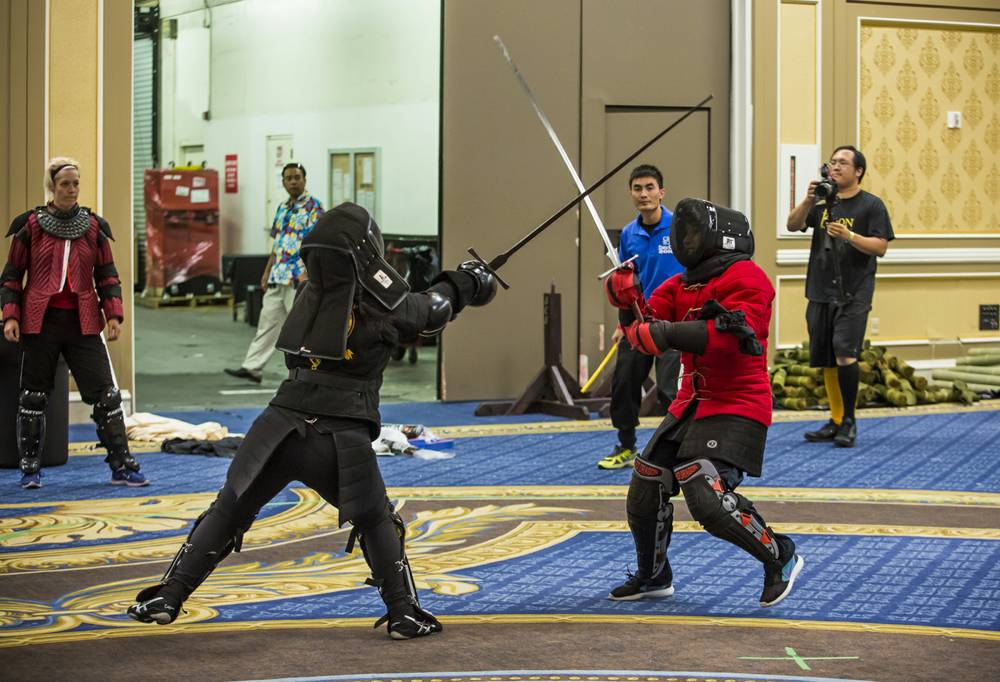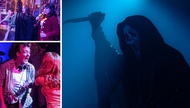I’ve never had to defend myself from a tomahawk attack. That kind of goes without saying. You probably haven’t either. (Maybe you have! Maybe you were an extra in The Last of the Mohicans and Daniel Day-Lewis went all methody on you. I don’t have time to vet your entire personal history.)
So when Dean, a grinning 20-something with nearly the same exact haircut as Mike Patton in Faith No More’s “Epic” video was swinging a rubber tomahawk at my neck, it piqued a lot of simultaneous thoughts. Like, I would definitely get murdered in a tomahawk attack, and He seems way too happy about this hypothetical tomahawk murder, and I haven’t listened to “Epic” in a while. I should fire that up on the ride home, assuming there’s no death by tomahawk. Wait, wasn’t Mike Patton in a band called Tomahawk? That’s a weird coincide—OH GOD, MY NECK.
This is, it turns out, par for the course at CombatCon, an annual convention of stage fighters, western martial arts enthusiasts, writers, the odd Jedi cosplayer or two and a whole bunch of dudes who can bring their own swords to something like this. It all happened the same weekend, July 7-10, across the hall from the World Series of Beer Pong at the Westgate Las Vegas Resort. This seems, at best, like a poor scheduling choice. The potential for nerd-on-bro violence feels remarkably high.
Steve Huff teaches Tomahawk 101. He starts by saying he studied the weapon under Col. Dwight McLemore, who is “a very scary man.” This is, I suppose, as good a qualification as any for tomahawk murder.
Apparently there are special forces units that still carry tomahawks, so it’s not impractical to learn this stuff. The tomahawks are important tools for breaching doors, Huff says. And, presumably, for defending Fort Necessity.
The class is a brief introduction to basic technique, and then pairing off to practice drills. Huff leads off his intro by saying “We all know the angles of attack, right?” Everyone else nods blithely. Now might not be the time to ask what the angles of attack are. He keeps referencing illustrations from Renaissance fencing manuals to bust up the room. He's the Dennis Miller of highly specific martial knowledge.
My second partner is another Steve, a gangly, balding Brit who brought his own knife and tomahawk. He had the courtesy to keep them in their leather sheaths, for which I’m eternally grateful. While we’re practicing, he keeps making little fwoosh noises to go with his cuts. I have to fight the urge to tell him I have a force-field up, so his hits just bounced off me. I didn’t want him to get one of the big kids from the sixth grade to gang up on me. The next two partners are older guys with ponytails. There are a disproportionate number of ponytails up in this piece.
“It’s funny because people think, MMA, that’s the new thing, but the Greeks were doing it. They called it pankration,” Huff said. “Just like these other communities you see them grow and build. With the western martial arts community, 20 years ago there were five or six guys around the country doing it. Now there’s like five groups in Southern California alone. They’re having huge international tournaments. I was in Mexico City teaching at a German-themed swordfighting event, teaching Viking and gladiatorial combat.”
Western martial arts, where martial anthropologists of sorts try to re-create actual fighting techniques from centuries-old manuals, is something of a growing field. Russia boasts M-1 Medieval, an actual MMA league for knight fighting. Atlantic City’s Boardwalk Hall hosts the Mixed Weapons Martial Arts Championships August 27. The Historical European Martial Arts Alliance boasts more than 40 groups, including the Noble Science Academy, which operates both in Lorenzi Park and on the UNLV campus.
In the main ballroom at the Westgate, most of the booths are selling swords that range from “historically accurate stabbing tool” to “you were way into Warcraft as a teenager.” There’s a demonstration ring where a husband-and-wife team show proper bullwhip method. A writer sitting behind a stack of largely unsold books offers me a slice of cake as I walk past. Clearly, I look like the kind of dude more in tune to cake than swordplay.
In a side-room, there’s the “cutting tournament,” where competitors try to slice as artistically as possible through rolled up straw mats. In the same room there’s some kind of longsword fighting going on with actual, hopefully dull steel weapons. Two girls are going at it wearing a combination of Darth Vader-esque robes, fencing masks and catchers’ shin guards. One of them is very upset to the point of screaming. I’m not sure why, but inquiring at angry people holding two-handed steel weapons doesn’t seem like a great idea.
The afternoon class is in Viggiani’s smallsword. I have no idea who Viggiani is, why his sword is small, or if that’s supposed to be an insulting euphemism for Renaissance Italians everywhere. It’s taught by Kyle Rowling, a tall, vulgar (and ponytailed) Australian who starts his class by saying “My name is Kyle. I don’t know if you’re here for me or for Viggiani, and frankly, I don’t care.” Kyle gets me.
Viggiani’s jam is fighting with the kinds of swords that showed up after longswords were too cumbersome, but before rapiers came into play. In practice, this means a lot of work with closet rods cut in half.
Rowling’s background is in staging fights for the theater, so he sets the scene for his instruction by quoting Mercutio taunting Tybalt and punctuates it at the end with, “Really, bitch?” He also served as Christopher Lee’s fighting double and General Grievous’ stand-in in Attack of the Clones and Revenge of the Sith. If I ever had to pick just one Sydney stage veteran to learn how to swordfight from, he would be the guy.
The first part of the class involved knocking away an overhead, chopping attack. Adam, a bearded fellow in his mid 40s, kept stopping to shake out his wrists, because it turns out closet rods start to feel heavy after you whack at them over and over. Admittedly, beating back an attack ended in a satisfying clunk and the smell of burning wood. It was all rather rustic. Just a bunch of dudes trying not to break each other’s knuckles while an Aussie swears at them, with a pleasant autumnal aroma on the breeze.
If anyone ever comes at me with a closet rod, and I also have a closet rod, I am like 60 percent sure I can now ruin that guy’s day. Home Depot shoppers, beware.




